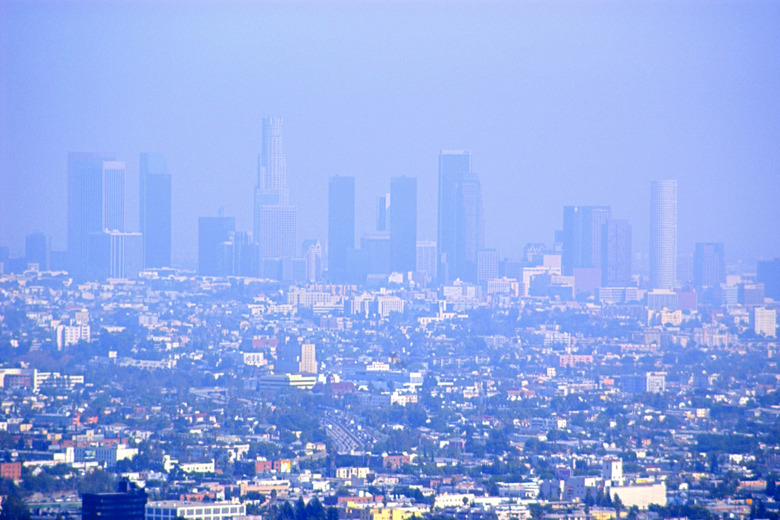Types Of Air Pollution: Smog And Acid Rain
Smog and acid rain are produced through similar sources, primarily vehicle and industry emissions. Though both result from human-caused air pollutants, there are chemical distinctions between the two. Though there are regulations in effect to reduce both types of pollution, they remain a threat to both human health and the environment.
Smog Causes
Smog Causes
A combination of three components — nitrogen oxides, volatile organic compounds (VOCs) and sunlight — causes smog. Nitrogen dioxide interacts with sunlight to create nitrogen oxide and a free oxygen molecule. This interaction produces ozone, which typically turns back into nitrogen dioxide, and the cycle repeats. The addition of VOCs interrupts the cycle, however. VOCs are produced by various sources, such as paint, cleaning products and refrigerants. The VOCs prevent the breakdown of ozone, allowing it to gather near the surface of the Earth, where even more nitric oxides are produced by vehicle and industry emissions, creating the dense smog seen in large cities such as Los Angeles and Beijing.
Smog Hazards
Smog Hazards
The presence of ozone in the form of smog can have several negative health effects. Respiratory systems can be irritated, reducing overall lung function and triggering asthma attacks. Evidence reported by the Environmental Protection Agency also suggests exposure to ozone reduces immune system responses, especially in the lungs. These effects subside over time, but little is known about the long-term effects of repeated exposure. Vegetation also suffers from smog, as plants that take up too much ozone can be damaged in ways such as discoloration and a loss of leaves that cuts photosynthesis efficiency by up to 50 percent.
Acid Rain Causes
Acid Rain Causes
Acid rain occurs when emissions from vehicles and industry sources interact with chemicals in the atmosphere. The biggest contributors to acid rain are sulfur dioxide and nitric oxides. These components interact with oxygen and water vapor in the air, creating compounds that are acidified close to 5 on the pH scale, well under the neutral 7 pH. The "rain" then comes in two forms: wet precipitate and dry particulates, which can enter the environment. Though the Clean Air Act of 1972 has reduced the amount of sulfur dioxide and nitric oxides entering the atmosphere, a new player, ammonia, is adding to the pH imbalance and is not currently regulated.
Acid Rain Hazards
Acid Rain Hazards
Acid rain's main impact is on the environment, especially bodies of water and soil quality. Lakes, like those in the Adirondack Mountains in New York, have had nearly the entire population of fish die off due to acidification. Soil acidification can lead to severe damage to trees, killing off the foliage, leaving them with limited means to gather nutrients. For human health, the dry particles do more damage than the wet precipitation. The particles can be carried on the wind over long distances, and when inhaled, they can trigger respiratory issues like asthma and bronchitis.
References
- U.S. Environmental Protection Agency: Smog — Who Does It Hurt?
- University of California, Berkeley: All that Smog
- University of California, Davis: Smog
- U.S. Environmental Protection Agency: Causes of Acid Rain
- U.S. Environmental Protection Agency: Effects of Acid Rain – Forests
- U.S. Environmental Protection Agency: Effects of Acid Rain – Human Health
- Colgate University: The Mechanics of Acid Rain
Cite This Article
MLA
Michelle, Meg. "Types Of Air Pollution: Smog And Acid Rain" sciencing.com, https://www.sciencing.com/types-air-pollution-smog-acid-rain-23483/. 24 April 2017.
APA
Michelle, Meg. (2017, April 24). Types Of Air Pollution: Smog And Acid Rain. sciencing.com. Retrieved from https://www.sciencing.com/types-air-pollution-smog-acid-rain-23483/
Chicago
Michelle, Meg. Types Of Air Pollution: Smog And Acid Rain last modified March 24, 2022. https://www.sciencing.com/types-air-pollution-smog-acid-rain-23483/
